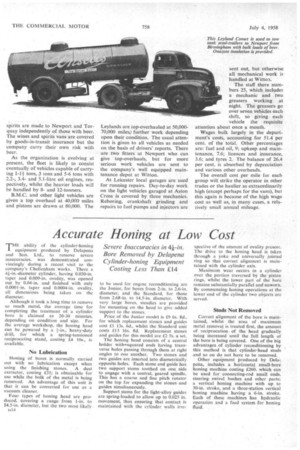Ho n ing Accurate 'wrung at Low Cost Severe Inaccuracies in 4i-in.
Page 60

If you've noticed an error in this article please click here to report it so we can fix it.
Bore Removed by Delapena Cylinder-honing Equipment Costing Less Than £14 THE ability of the cylinder-honing equipment produced by Delapena and Son, Ltd., to remove severe inaccuracies, was demonstrated convincingly during a recent visit to the company's Cheltenham works. There a 4-in.-diameter cylinder, having 0.030-in. taper and 0.009-in. ovality, was opened out by 0.04-in, and finished with only 0.0001-in, taper and 0.0004-in. ovality, all dimensions being taken on the diameter.
Although it took a long time to remove so much metal, the average time for completing the treatment of a cylinder bore is claimed as 20-30 minutes, depending on condition and size. For the average workshop, the honing head can be powered by a 1-in., heavy-duty drill, for which a spring-tensioned reciprocating stand, costing 14 10s., is available.
No Lubrication
Honing of bores is normally carried out with no lubrication except when using the finishing stones. A dust extractor, costing £31: is obtainable for use while the bulk of the metal is being removed. An advantage of this unit is that it can be converted for use as a vacuum cleaner.
Four types of honing head are produced, covering a range from 1-in, to 14.5-in. diameter, but the two most likely.
olct to be used for engine reconditioning are the Junior, for bores from 2-in. to 2.6-in. diameter, and the Standard, for those from 2.68-in. to 14.5-in. diameter. With very large bores, steadies are provided for mounting on the head to give added support to the stones.
Price of the Junior model is £9 fis. 8d., for which replacement stones and _guides cost £1 13s. 6d., whilst the Standard unit costs £13 16s. 8d. Replacement stones and guides for this model are £2 5s. a set.
The honing head consists of a central holder withmsquared ends having transverse holes passing through them at right angles to one another. Two stones and two guides are inserted into diametrically opposite holes. Each stone and guide has two support stems toothed on one side to engage with a central, geared spindle. This has a coarse and fine pitch rotator on the top for expanding the stones and guides simultaneously.
Support stems for the light-alloy guides are spring-loaded to allow up to 0.025 in. movement, thus ensuring that contact is maintained with the cylinder walls irre
spective of the amount of ovality present. The drive to the honing head is taken through a yoke and universally jointed ring so that correct alignment is maintained with the cylinder axis.
Maximum wear occurs in a cylinder over the portion traversed by the piston rings, whilst the lower part of the bore remains substantially parallel and unworn. By commencing honing operations at the lower end of the cylinder two objects are served.
Studs Not Removed Correct alignment of the bore is maintained, whilst the area of , maximum metal removal is treated first, the amount of reciprocation, of the head gradually being increased until the full length of the bore is being covered. One of the big advantages of cylinder reconditioning by this method is that • cylinder-head studs and so on do not have to be removed.
Other equipment produced by Dela; perm, includes a horizontal small-bore honing machine costing £260, which can be used for connecting-rod small ends, steering swivel bushes and other parts; a vertical honing machine with up to 30-in, stroke, and a three-station vertical honing machine having a 6-in, stroke. Each of these machines has hydraulic operation and a feed system for honing fluid.




























































































































